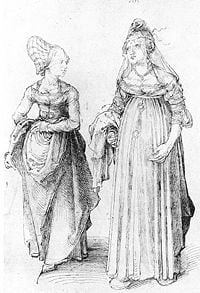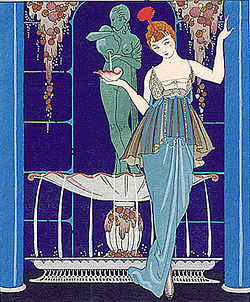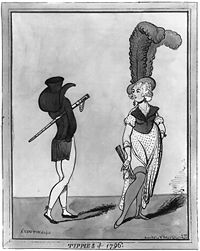Fashion
The term "fashion" usually applies to a prevailing mode of expression, but quite often applies to a personal mode of expression that may or may not apply to all. Inherent in the term is the idea that the mode will change more quickly than the culture as a whole. The terms "fashionable" and "unfashionable" are employed to describe whether someone or something fits in with the current popular mode of expression. The term "fashion" is frequently used in a positive sense, as a synonym for glamour and style. In this sense, fashions are a sort of communal art, through which a culture examines its notions of beauty and goodness. The term "fashion" is also sometimes used in a negative sense, as a synonym for fads, trends, and materialism.
History of Fashion

The habit of continually changing the style of clothing worn, which is now worldwide, at least among urban populations, is a distinctively Western one. Though there are signs from earlier, it can be fairly clearly dated to the middle of the 14th century, to which historians including James Laver and Fernand Braudel date the start of fashion in clothing.[1] [2] The most dramatic manifestation was a sudden drastic shortening and tightening of the male over-garment, from calf-length to barely covering the buttocks, sometimes accompanied with stuffing on the chest. This created the distinctive Western male outline of a tailored top worn over leggings or trousers which is still with us today.
The pace of change accelerated considerably in the following century, and womens fashion, especially in the dressing and adorning of the hair, became equally complex and changing. Art historians are able to date images with increasing confidence and precision, to a period of about five years for the 15th century. Initially changes in fashion led to a fragmentation of what had previously been very similar styles of dressing across the upper classes of Europe, and the development of distinctive national styles, which remained very different until a counter-movement in the 17th to 18th centuries imposed similar styles once again, finally those from Ancien regime France.[3] Though fashion was always led by the rich, the increasing affluence of Early Modern Europe led to the bourgeoisie and even peasants following trends at a distance sometimes uncomfortably close for the elites - a factor Braudel regards as one of the main motors of changing fashion. [4]
The fashions of the West are unparalleled either in antiquity or in the other great civilizations of the world. Early Western travellers, whether to Persia, Turkey, Japan or China frequently remark on the absence of changes in fashion there, and observers from these other cultures comment on the unseemly pace of Western fashion, which many felt suggested an instability and lack of order in Western culture. The Japanese Shogun's secretary boasted (not completely accurately) to a Spanish visitor in 1609 that Japanese clothing had not not changed in over a thousand years. [5]
Ten 16th century portraits of German or Italian gentlemen may show ten entirely different hats, and at this period national differences were at their most pronounced, as Albrecht Dürer recorded in his actual or composite contrast of Nuremberg and Venetian fashions at the close of the 15th century (illustration, right). The "Spanish style" of the end of the century began the move back to synchronicity among upper-class Europeans, and after a struggle in the mid 17th century, French styles decisively took over leadership, a process completed in the 18th century.[6]
Though colors and patterns of textiles changed from year to year,[7] the cut of a gentleman's coat and the length of his waistcoat, or the pattern to which a lady's dress was cut changed more slowly. Men's fashions largely derived from military models, and changes in a European male silhouette are galvanized in theatres of European war, where gentleman officers had opportunities to make notes of foreign styles: an example is the "Steinkirk" cravat or necktie.
The pace of change picked up in the 1780s with the increased publication of French engravings that showed the latest Paris styles; though there had been distribution of dressed dolls from France as patterns since the sixteenth century, and Abraham Bosse had produced engravings of fashion from the 1620s. By 1800, all Western Europeans were dressing alike (or thought they were): local variation became first a sign of provincial culture, and then a badge of the conservative peasant [8].
Although tailors and dressmakers were no doubt responsible for many innovations before, and the textile industry certainly led many trends, the History of fashion design is normally taken to date from 1858, when the English-born Charles Frederick Worth opened the first true haute couture house in Paris. Since then the professional designer has become a progressively more dominant figure, despite the origins of many fashions in street fashion.
Fashion in clothes has allowed wearers to express emotion or solidarity with other people for millennia. Modern Westerners have a wide choice available in the selection of their clothes. What a person chooses to wear can reflect that person's personality or likes. When people who have cultural status start to wear new or different clothes a fashion trend may start. People who like or respect them may start to wear clothes of a similar style.
Fashions may vary significantly within a society according to age, social class, generation, occupation and geography as well as over time. If, for example, an older person dresses according to the fashion of young people, he or she may look ridiculous in the eyes of both young and older people. The terms "fashionista" or "fashion victim" refer to someone who slavishly follows the current fashions (implementations of fashion).
One can regard the system of sporting various fashions as a fashion language incorporating various fashion statements using a grammar of fashion. (Compare some of the work of Roland Barthes.)
Marketing Fashion
The Evolution of Fashion
Fashion, by definition, changes constantly. Fashions are a social psychology phenomena common to many fields of human activity and thinking. [9] For some, modern fast-paced changes in fashion embody many of the negative aspects of capitalism: it results in waste and encourages people qua consumers to buy things unnecessarily. Other people, especially young people, enjoy the diversity that changing fashion can apparently provide, seeing the constant change as a way to satisfy their desire to experience "new" and "interesting" things. Note too that fashion can change to enforce uniformity, as in the case where so-called Mao suits became the national uniform of mainland China.
At the same time there remains an equal or larger range designated (at least currently) 'out of fashion'. (These or similar fashions may cyclically come back 'into fashion' in due course, and remain 'in fashion' again for a while.)
Practically every aspect of appearance that can be changed has been changed at some time, for example skirt lengths ranging from ankle to mini to so short that it barely covers anything, etc. In the past, new discoveries and lesser-known parts of the world could provide an impetus to change fashions based on the exotic: Europe in the eighteenth or nineteenth centuries, for example, might favor things Turkish at one time, things Chinese at another, and things Japanese at a third. A modern version of exotic clothing includes club wear. Globalization has reduced the options of exotic novelty in more recent times, and has seen the introduction of non-Western wear into the Western world.
Fashion houses and their associated fashion designers, as well as high-status consumers (including celebrities), appear to have some role in determining the rates and directions of fashion change.
Fashion Evolution and Social Theory
Hans Simmel suggests that fashion is a method for the individual to assert him or her self. He says that society attempts to homogenize its inhabitants through the same daily interactions, and fashion allows a person to declare who they are, because life has become too fast paced to develop strong bonds with everyone in a community. People change the fashions constantly to continuously display their individuality, and our sense of self is fluid throughout our lifetime. At the same time, fashion can mark people as conformists: in the work place, especially associated with the division of labor, most workers wear similar styles of clothes, or very formal attire. This takes away individuality from workers and laborers, marking them as conformists to the work world.
Fashion in the Media
An important part of fashion is fashion journalism. Editorial critique and commentary can be found in magazines, newspapers, on television, fashion websites and in fashion blogs.
At the beginning of the twentieth century, fashion magazines began to include photographs and became even more influential than in the past. In cities throughout the world these magazines were greatly sought-after and had a profound effect on public taste. Talented illustrators drew exquisite fashion plates for the publications which covered the most recent developments in fashion and beauty. Perhaps the most famous of these magazines was La Gazette du bon ton which was founded in 1912 by Lucien Vogel and regularly published until 1925 (with the exception of the war years).
Vogue, founded in the US in 1902, has been the longest-lasting and most successful of the hundreds of fashion magazines that have come and gone. Increasing affluence after World War II and, most importantly, the advent of cheap colour printing in the 1960s led to a huge boost in their sales, and heavy coverage of fashion in mainstream women's magazines - followed by men's magazines from the 1990s. Haute Couture designers followed the trend by starting the ready-to-wear and perfume lines, heavily advertised in the magazines, that now dwarf their original couture businesses. Television coverage began in the 1950s with small fashion features. In the 1960s and 1970s, fashion segments on various entertainment shows became more frequent, and by the 1980s, dedicated fashion shows like FashionTelevision started to appear. Despite television and increasing internet coverage, including fashion blogs, press coverage remains the most important form of publicity in the eyes of the industry.
Fashion in Television and Movies
The Fashion Industry and Intellectual Property
Within the fashion industry, intellectual property enforcement operates quite differently than in other content industries. Whereas IP enforcement is often seen as a key issue within the film industry and music industry, many have suggest that lack of enforcement contributes positively to the industry. [1] Copying and emulating previously existing fashions are not seen by some as detrimental to the industry, but rather as a force for continuous cultural evolution. [2]. Others have contend that the negative financial effect that this can have on smaller, boutique, designers. [3]
Somewhat conversely, the World Intellectual Property Organization (WIPO) held a conference in 2005 that illuminated the need for stricter IP enforcement within the fashion industry to better protect SME's (Small and Medium Enterprises) and promote competitiveness within the textile and clothing industries. [4][5]
Quotes
- "Fashion is not something that exists in dresses only. Fashion is in the sky, in the street, fashion has to do with ideas, the way we live, what is happening." - Coco Chanel
- "Fashion is made to become unfashionable." - Coco Chanel [6]
- "Fashion is a form of ugliness so intolerable that we have to alter it every six months." - Oscar Wilde [7]
Notes
- ↑ Laver, James: The Concise History of Costume and Fashion, Abrams, 1979, p. 62
- ↑ Fernand Braudel, Civilization and Capitalism, 15th-18th Centuries, Vol 1: The Structures of Everyday Life," p317, William Collins & Sons, London 1981
- ↑ Fernand Braudel, Civilization and Capitalism, 15th-18th Centuries, Vol 1: The Structures of Everyday Life," p317-24, William Collins & Sons, London 1981
- ↑ Fernand Braudel, Civilization and Capitalism, 15th-18th Centuries, Vol 1: The Structures of Everyday Life," p313-15, William Collins & Sons, London 1981
- ↑ Fernand Braudel, Civilization and Capitalism, 15th-18th Centuries, Vol 1: The Structures of Everyday Life," p.312-3, p.323, William Collins & Sons, London 1981
- ↑ Fernand Braudel, Civilization and Capitalism, 15th-18th Centuries, Vol 1: The Structures of Everyday Life," p.317-21, William Collins & Sons, London 1981
- ↑ Thornton, Peter. Baroque and Rococo Silks.
- ↑ James Laver and Fernand Braudel, ops cit
- ↑ For a discussion of the use of the terms "fashion," "dress," "clothing" and "costume" by professionals in various disciplines, see Valerie Cumming, Understanding Fashion History, "Introduction," Costume & Fashion Press, 2004, ISBN 0-8967-6253-X
ReferencesISBN links support NWE through referral fees
- Cumming, Valerie: Understanding Fashion History, Costume & Fashion Press, 2004, ISBN 0-8967-6253-X
External links
- Fashion at the Open Directory Project
- The British Library The British Library - finding information on the fashion industry
Credits
New World Encyclopedia writers and editors rewrote and completed the Wikipedia article in accordance with New World Encyclopedia standards. This article abides by terms of the Creative Commons CC-by-sa 3.0 License (CC-by-sa), which may be used and disseminated with proper attribution. Credit is due under the terms of this license that can reference both the New World Encyclopedia contributors and the selfless volunteer contributors of the Wikimedia Foundation. To cite this article click here for a list of acceptable citing formats.The history of earlier contributions by wikipedians is accessible to researchers here:
The history of this article since it was imported to New World Encyclopedia:
Note: Some restrictions may apply to use of individual images which are separately licensed.

